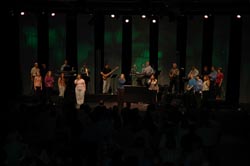- MACON, GA-SportsTowne is a 116,000-square-foot recreational facility that houses three arenas, a couple weight rooms, and Christ Chapel's biweekly masses. How is it possible that such a facility could offer a proper environment for these masses with over 1,000 attendees? The answer lies in a single cable that runs over 64 channels of audio.
Christ Chapel's sound system is run through a Cat-5 cable up to the inner ear monitors of the performers on stage.
The attendees of Christ Chapel purchased SportsTowne from a prominent businesswoman in the community who had built the facility to give her arena football team a practice space. She also decided to build the other arenas within to provide a club for the community. Unfortunately it never took off, so Christ Chapel acquired it on the promise that it would still provide for the community.
The three arenas are quite diverse in structure. One's an indoor hockey rink that turns into three volleyball courts. The middle arena, which is used for the sanctuary, is comprised of three basketball courts that also turn into three tennis courts. There's even a net that drops down if users want to play both. Finally, the other arena is a football/soccer field. Such a diverse and large building requires a maximum level of portability to provide adequate services biweekly.
Bryan Nichols, technical director of Christ Church and project manager for Total Systems AV, handled the installation of the sound system for Christ Chapel. Since portability was such an issue, Nichols researched the possibilities carefully. "We needed something we could unhook daily if we needed to and get out of the way. But when we hooked it all back up it'd be quick and easy and have the same high quality as a permanent install. But it's still a sports facility, and they have concerts and leagues. So portability was very important."
Nichols went with Aviom's A-Net technology to run audio over Cat-5 cable. With Aviom's AN-16i-M mic input modules, AN-16i input modules, and an AN-16SB system bridge, Nichols is able to run 64 channels over a single line. He even added a couple devices to save time. "We actually ran it through a patch bay so we could even change places that things were located. So if a guitar player changed inputs or something we could just repatch him. We have a monitor console, an FOH console, and a broadcast console, so it saves us the trouble of communicating up to the broadcast console about input changes. With the repatch it will still go through the same channel."
Nichols put Cat-5 jacks throughout the building to allow complete portability for the gear. "The sound booth is on wheels, so we just unplug the Cat-5 from a jack under the bleachers and go," he said. "We run all our DMX lighting over Cat-5, all sound over Cat-5, all our video over Cat-5. So we really just have a bunch of Cat-5 jacks all over the facility. We have a patch bay for Cat-5. So literally from the same Cat-5 jack I ran sound from last week, I could run a camera line into it and have it run to the broadcast booth and be on TV from the same jack. With things going Cat-5 it's very versatile throughout. No more worries about bleed-through and noise."
After a mass, the sound booth is easy to hide from league play, as Nichols explained. "The stage is a huge concert rig that takes up one basketball court, so when we unlock the sound booth, we push it up next to the stage. There's a big curtain to that comes down from the ceiling that hides the booth and the stage. It literally takes us 15 minutes to tear down. We tell everyone to grab a chair and stack it. It takes about 45 minutes to an hour to set all the chairs back up, but the Cat-5 makes the rest a snap."
Using the A-Net modules has saved a lot of time as well for Nichols. "We use the Yamaha M7CLs consoles and they have Aviom cards that slide into the back of them. The Cat-5 comes straight out of the console now, saving a lot of time. We not only run 48 channels of audio, from the stage to the FOH to the broadcast booth and to the monitors, but we run 16 more channels going to the personal ear monitors for each band member on the same cable."
Nichols can't stop himself from heaping praise on the Aviom A-Net technology. He has switched over to installing it in almost all of his new jobs. "I've never had a glitch or anything go wrong. If the cable wears out, its cheaper than copper. And they make locking ends. I can't say enough about the Cat-5. I've never had a buzz again."
